Geographic Information System-Based Framework for Sustainable Small and Medium-Sized Enterprise Logistics Operations
Abstract
1. Introduction
2. Materials and Methods
2.1. Current Method Used by the Partner and Other Third-Party Logistics Companies
2.2. Proposed GIS-Based Framework
- request.truck [0].startLocation -> transitions [0] -> visits [0] ->
- transitions [1] -> visits [1] -> transitions [2] -> … -> visits [n] ->
- transitions [n] -> request.truck [0].endLocation.
2.3. Roles and User Access in the Application Software
2.4. Dataflow in the GIS Framework
2.5. Developed Application Interface
| FUNCTION searchLocation (locationName) IF the length of locationName is greater than 1 THEN CONSTRUCT the API URL for Google Places Autocomplete using the locationName and the Google Maps API key; SEND a request to the Places API using the constructed URL; AWAIT the response from the Places API END IF IF an error occurs during the API request THEN RETURN to the function END IF IF the response status from the Places API is “OK” THEN EXTRACT the predictions from the response; MAP each prediction to a PredictionModel object; CONVERT the mapped predictions to a list; UPDATE the dropOffPredictionsPlacesList state variable with the list of predictions END IF END FUNCTION |
| FUNCTION initializeGeoFireListener () INITIALIZE GeoFire with the database reference “onlineDrivers”; QUERY nearby drivers using the current latitude and longitude of the user with a radius of 22 units; LISTEN for changes in the nearby drivers query results IF the driver event is not null THEN RETRIEVE the child event type from the driver event; SWITCH CASE on the child event type IF the event is Geofire.onKeyEntere THEN CREATE a new OnlineNearbyDrivers object; POPULATE the object with the driver’s uid, latitude, and longitude; ADD the driver to the nearbyOnlineDriversList; IF nearbyOnlineDriversKeysLoaded is true THEN UPDATE the drivers on the Google Map END IF IF the event is Geofire.onKeyExited THEN REMOVE the driver from the nearbyOnlineDriversList; UPDATE the available online drivers on the map END IF IF the event is Geofire.onKeyMoved THEN CREATE a new OnlineNearbyDrivers object; UPDATE the object with the driver’s UID, latitude and longitude; UPDATE the location of the driver in the nearbyOnlineDriversList; UPDATE the available online drivers on the map END IF IF the event is Geofire.onGeoQueryReady THEN SET nearbyOnlineDriversKeysLoaded to true UPDATE the available online drivers on the map END IF END SWITCH CASE END IF END FUNCTION |
2.6. Data Collection Methods
2.7. Freight Rate Matrix Provided by the Partner Logistics Company
2.8. Freight Rate Matrix Provided by the Researchers
3. Results and Discussions
3.1. Elapse Time and Job Request
3.2. Distance Traveled, Fuel Expenses, and CO2 Emissions
3.3. Projected Savings from Operating Expenses
3.4. Projected Revenue and Profit from Completed Service Requests
3.5. User Acceptance
4. Conclusions and Recommendations
Author Contributions
Funding
Data Availability Statement
Acknowledgments
Conflicts of Interest
References
- Hendricks, S.; Mwapwele, S.D. A systematic literature review on the factors influencing e-commerce adoption in developing countries. Data Inf. Manag. 2024, 8, 100045. [Google Scholar] [CrossRef]
- Salah, O.H.; Ayyash, M.M. E-commerce adoption by SMEs and its effect on marketing performance: An extended of TOE framework with ai integration, innovation culture, and customer tech-savviness. J. Open Innov. Technol. Mark. Complex. 2024, 10, 100183. [Google Scholar] [CrossRef]
- Zeng, S.; Fu, Q.; Haleem, F.; Han, Y.; Zhou, L. Logistics density, E-commerce and high-quality economic development: An empirical analysis based on provincial panel data in China. J. Clean. Prod. 2023, 426, 138871. [Google Scholar] [CrossRef]
- Aristio, A.P.; Mudjahidin, M.; Halim, J.P.; Junaedi, L.; Supardi, S.; Utomu, G.P. Supardi, Ismail, Gatut Prijo Utomu, Model Development of Factors Affecting Intention to Use in Third-Party Logistics. Procedia Comput. Sci. 2024, 234, 813–820. [Google Scholar] [CrossRef]
- Zarbakhshnia, N.; Karimi, A. Enhancing third-party logistics providers partnerships: An approach through the D.L.A.R.C.S supply chain paradigm. Resour. Conserv. Recycl. 2024, 202, 107406. [Google Scholar] [CrossRef]
- Dolan, S. Last mile delivery logistics explained: Problems & solutions. Insid. Intell. 2022, 15. [Google Scholar]
- Chen, E.; Zhou, Z.; Li, R.; Chang, Z.; Shi, J. The multi-fleet delivery problem combined with trucks, tricycles, and drones for last-mile logistics efficiency requirements under multiple budget constraints. Transp. Res. Part E: Logist. Transp. Rev. 2024, 187, 103573. [Google Scholar] [CrossRef]
- Onfleet, Inc. What Is a last mile delivery? Delivered Blog. Available online: https://onfleet.com/blog/what-is-last-mile-delivery/ (accessed on 1 August 2024).
- Mai, T. What Is Reverse Logistics? How It Works and Types, March 2022, Magenest. Available online: https://magenest.com/en/what-is-reverse-logistics/ (accessed on 1 August 2024).
- Yanpirat, N.; Silva, D.F.; Smith, A.E. Sustainable last mile parcel delivery and return service using drones. Eng. Appl. Artif. Intell. 2023, 124, 106631. [Google Scholar] [CrossRef]
- Truck Dispatcher Job Description, Betterteam. Available online: https://www.betterteam.com/truck-dispatcher-job-description (accessed on 1 August 2024).
- Kaushik, S. Common Challenges in Scheduling and Dispatch Management, LinkedIn. Available online: https://www.linkedin.com/pulse/common-challenges-scheduling-dispatch-management-suyash-Kaushik (accessed on 1 August 2024).
- Büyükdeveci, Ö.; Özpeynirci, S.; Özpeynirci, Ö. Multi-objective shipment consolidation and dispatching problem. Comput. Oper. Res. 2024, 169, 106728. [Google Scholar] [CrossRef]
- Crippa, M.; Guizzardi, D.; Solazzo, E.; Muntean, M.; Schaaf, E.; Monforti-Ferrario, F.; Banja, M.; Olivier, J.; Grassi, G.; Rossi, S. GHG Emissions of All World Countries. EUR 30831 EN; Publications Office of the European Union: Luxembourg, 2021; ISBN 978-92-76-41546-6. [Google Scholar]
- Pörtner, H.-O.; Roberts, D.C.; Tignor, M.M.B.; Poloczanska, E.S.; Mintenbeck, K.; Alegría, A.; Craig, M.; Langsdorf, S.; Löschke, S.; Möller, V. (Eds.) Climate Change 2022: Impacts, Adaptation and Vulnerability. In Contribution of Working Group II to the Sixth Assessment Report of the Intergovernmental Panel on Climate Change; Cambridge University Press: Cambridge, UK; New York, NY, USA, 2022. [Google Scholar]
- Siragusa, C.; Tumino, A.; Mangiaracina, R.; Perego, A. Electric Vehicles Performing Last-Mile Delivery in B2C e-Commerce: An Economic and Environmental Assessment. Int. J. Sustain. Transp. 2022, 16, 22–33. [Google Scholar] [CrossRef]
- Ghosh, P.; Jha, A.; Sharma, R.R.K. Managing carbon footprint for a sustainable supply chain: A systematic literature review. Mod. Supply Chain. Res. Appl. 2020, 2, 123–141. [Google Scholar] [CrossRef]
- Sherafati, M.; Bashiri, M.; Tavakkoli-Moghaddam, R.; Pishvaee, M.S. Achieving sustainable development of supply chain by incorporating various carbon regulatory mechanisms. Transp. Res. Part D Transp. Environ. 2020, 81, 102253. [Google Scholar] [CrossRef]
- Quak, H.; Nesterova, N.; Rooijen, T.; Dong, Y. Zero emission city logistics: Current practices in freight electromobility and feasibility in the near future. Transp. Res. Procedia 2016, 14, 1506–1515. [Google Scholar] [CrossRef]
- Kopfer, H.W.; Schönberger, J.; Kopfer, H. Reducing Greenhouse Gas Emissions of a Heterogeneous Vehicle Fleet. Flex Serv. Manuf. J. 2014, 26, 221–248. [Google Scholar] [CrossRef]
- Schöder, D.; Ding, F.; Campos, J.K. The Impact of E-Commerce Development on Urban Logistics Sustainability. Open J. Soc. Sci. 2016, 4, 1–6. [Google Scholar] [CrossRef]
- Wang, J.; Lim, M.K.; Zhan, Y.; Wang, X. An intelligent logistics service system for enhancing dispatching operations in an IoT environment. Transp. Res. Part E Logist. Transp. Rev. 2020, 135, 101886. [Google Scholar] [CrossRef]
- Ouyang, Z.; Leung EK, H.; Huang, G.Q. Community logistics for dynamic vehicle dispatching: The effects of community departure “time” and “space”. Transp. Res. Part E Logist. Transp. Rev. 2022, 165, 102842. [Google Scholar] [CrossRef]
- Yücel, E.; Salman, F.S.; Erdoğan, G. Optimizing two-dimensional vehicle loading and dispatching decisions in freight logistics. Eur. J. Oper. Res. 2022, 302, 954–969. [Google Scholar] [CrossRef]
- Gendreau, M.; Guertin, F.; Potvin, J.Y.; Séguin, R. Neighborhood search heuristics for a dynamic vehicle dispatching problem with pick-ups and deliveries. Transp. Res. Part C Emerg. Technol. 2006, 14, 157–174. [Google Scholar] [CrossRef]
- Sallem, R.; Serbaji, M.M.; Alamri, A.M.; Kallel, A.; Trabelsi, I. Optimal routing of household waste collection using ArcGIS application: A case study of El Bousten district, Sfax city, Tunisia. Arab. J. Geosci. 2021, 14, 1038. [Google Scholar] [CrossRef]
- Akram, M.; Habib, A.; Alcantud, J.C.R. An optimization study based on Dijkstra algorithm for a network with trapezoidal picture fuzzy numbers. Neural Comput. Appl. 2021, 33, 1329–1342. [Google Scholar] [CrossRef]
- Zhu, S.; Wang, C. An interaction-enhanced co-evolutionary algorithm for electric vehicle routing optimization. Appl. Soft Comput. 2024, 165, 112113. [Google Scholar] [CrossRef]
- Yang, J.; Lau, H.C.; Wang, H. Optimization of customer service and driver dispatch areas for on-demand food delivery. Transp. Res. Part C Emerg. Technol. 2024, 165, 104653. [Google Scholar] [CrossRef]
- Ding, M.; Guo, Y.; Huang, Z.; Lin, B.; Luo, H. GROM: A generalized routing optimization method with graph neural network and deep reinforcement learning. J. Netw. Comput. Appl. 2024, 229, 103927. [Google Scholar] [CrossRef]
- Fernando, A.H.; Guillermo, M.A.; Lim, L.A.G.; Bandala, A.A.; Vicerra, R.R.P.; Dadios, E.P.; Naguib, R.N. Load Pushing Capacity Analysis of Individual and Multi-Cooperative Mobile Robot through Symbiotic Application. Int. J. Mech. Eng. Robot. Res. 2024, 13. [Google Scholar] [CrossRef]
- Fernando, A.; GanLim, L. Velocity analysis of a six wheel modular mobile robot using MATLAB-Simulink. IOP Conf. Ser. Mater. Sci. Eng. 2021, 1109, 012037. [Google Scholar] [CrossRef]
- Kumar, P.; Hariharan, K.; Manikandan, M.S.K. Hybrid long short-term memory deep learning model and Dijkstra’s Algorithm for fastest travel route recommendation considering eco-routing factors. Transp. Lett. 2023, 15, 926–940. [Google Scholar]
- Liu, Y.; Gao, X.; Wang, B.; Fan, J.; Li, Q.; Dai, W. A passage time–cost optimal A* algorithm for cross-country path planning. Int. J. Appl. Earth Obs. Geoinf. 2024, 130, 103907. [Google Scholar] [CrossRef]
- De Oliveira Mota, D. Dynamic dispatch algorithm proposal for last-mile delivery vehicle. IEEE Lat. Am. Trans. 2021, 19, 1618–1623. [Google Scholar] [CrossRef]
- Nakechbandi, M.; Colin, J.Y. Studying the rerouting of empty carriers during their return trips to manage rare mobile resources in a physical internet. In Proceedings of the 2020 5th International Conference on Logistics Operations Management (GOL), Rabat, Morocco, 28–30 October 2020; pp. 1–6. [Google Scholar]
- Azari, M.; Jawab, F.; Arif, J.; Khaoua, Y.; El Jaouhari, A.; Moustabchir, H. From City Logistics to a Merger of Smart Cities and Smart Logistics. In Proceedings of the 2022 14th International Colloquium of Logistics and Supply Chain Management (LOGISTIQUA), El Jadida, Morocco, 25–27 May 2022; pp. 1–5. [Google Scholar]
- McDougall, J.A.; Otero, L.D. Optimal transfer point locations in two-stage distribution systems. IEEE Access 2017, 6, 1974–1984. [Google Scholar] [CrossRef]
- Abhilashani, G.K.; Ranathunga, M.I.D.; Wijayanayake, A.N. Minimising Last Mile Delivery Cost and Vehicle Usage Through an Optimised Delivery Network Considering Customer-Preferred Time Windows. In Proceedings of the 2023 International Research Conference on Smart Computing and Systems Engineering (SCSE), Kelaniya, Sri Lanka, 29 June 2023; Volume 6, pp. 1–7. [Google Scholar]
- Shee, H.; Miah, S.; Taboada, I.; De Vass, T. Smart City–Smart Logistics Amalgamation. In Proceedings of the 2020 IEEE European Technology and Engineering Management Summit (E-TEMS), Dortmund, Germany, 5–7 March 2020; pp. 1–4. [Google Scholar]
- Yongmei, R.; Linghong, H.; Yongqing, M. Logistics distribution route optimization method for peach products transport. In Proceedings of the 2015 Seventh International Conference on Measuring Technology and Mechatronics Automation, Nanchang, China, 13–14 June 2015; pp. 609–612. [Google Scholar]
- Wanganoo, L.; Patil, A. Preparing for the smart cities: IoT enabled last-mile delivery. In Proceedings of the 2020 Advances in Science and Engineering Technology International Conferences (ASET), Dubai, United Arab Emirates, 4 February–9 April 2020; pp. 1–6. [Google Scholar]
- Samouh, F.; Gluza, V.; Djavadian, S.; Meshkani, S.; Farooq, B. Multimodal autonomous last-mile delivery system design and application. In Proceedings of the 2020 IEEE International Smart Cities Conference (ISC2), Piscataway, NJ, USA, 28 September–1 October 2020; pp. 1–7. [Google Scholar]
- Jeon, A.; Kang, J.; Choi, B.; Kim, N.; Eun, J.; Cheong, T. Unmanned aerial vehicle last mile delivery considering backhauls. IEEE Access 2021, 9, 85017–85033. [Google Scholar] [CrossRef]
- Huang, Z.; Huang, Z.; Li, J.; Huang, D.; Fan, J.; Ng, W.W. No-Load Backhaul Ratio Reduction by Interactive Routing for Small Goods Delivery with Time Window Constraints. In Proceedings of the 2017 IEEE International Conference on Internet of Things (iThings) and IEEE Green Computing and Communications (GreenCom) and IEEE Cyber, Physical and Social Computing (CPSCom) and IEEE Smart Data (SmartData), Exeter, UK, 21–23 June 2017; pp. 299–305. [Google Scholar]
- Ma, H.; Kuang, H.; Huang, M. A last-mile delivery problem with alternative delivery options based on prospect theory. In Proceedings of the 2021 33rd Chinese Control and Decision Conference (CCDC), Kunming, China, 22–24 May 2021; pp. 4202–4207. [Google Scholar]
- Liu, W. Route optimization for last-mile distribution of rural E-commerce logistics based on ant colony optimization. IEEE Access 2020, 8, 12179–12187. [Google Scholar] [CrossRef]
- Damayanti, T.R.; Kusumaningrum, A.L.; Susanty, Y.D.; Islam, S.S. Route optimization using saving matrix method—A case study at public logistics company in indonesia. In Proceedings of the International Conference on Industrial Engineering and Operations Management, Detroit, MI, USA, 10–14 August 2020; pp. 1583–1591. [Google Scholar]
- Zhou, H.; Wang, Q.; Wang, L.; Zhao, X.; Feng, G. Digitalization and third-party logistics performance: Exploring the roles of customer collaboration and government support. Int. J. Phys. Distrib. Logist. Manag. 2023, 53, 467–488. [Google Scholar] [CrossRef]
- Dimitrov, I.; Dimitrova, A. Impact of using third-party logistics provider on organizational performance in the Bulgarian context. In Proceedings of the 2021 IV International Conference on High Technology for Sustainable Development (HiTech), Sofia, Bulgaria, 7–8 October 2021; pp. 1–4. [Google Scholar]
- Mangiaracina, R.; Perego, A.; Seghezzi, A.; Tumino, A. Innovative solutions to increase last-mile delivery efficiency in B2C e-commerce: A literature review. Int. J. Phys. Distrib. Logist. Manag. 2019, 49, 901–920. [Google Scholar] [CrossRef]
- Marques, A.; Soares, R.; Santos, M.J.; Amorim, P. Integrated planning of inbound and outbound logistics with a Rich Vehicle Routing Problem with backhauls. Omega 2020, 92, 102172. [Google Scholar] [CrossRef]
- Afrapoli, A.M.; Tabesh, M.; Askari-Nasab, H. A multiple objective transportation problem approach to dynamic truck dispatching in surface mines. Eur. J. Oper. Res. 2019, 276, 331–342. [Google Scholar] [CrossRef]
- Shah, S.R.; See, H.H.; Samadi, S. Applicability of Digital Tracking System on Third Party Logistics (TPL) Services. In Proceedings of the 2021 IEEE International Conference on Technology Management, Operations and Decisions (ICTMOD), Marrakech, Morocco, 24–26 November 2021; pp. 1–6. [Google Scholar]
- Othman, M.F.I.; Masrom, N.R.; Isnin, I.F.; Rasi, R.Z.; Abd Rahim, Y.; Arshad, Y. Blockchain Adoption Intention by a Third-Party Logistics Company: A Malaysian Case Study. In Proceedings of the 2021 7th International Conference on Research and Innovation in Information Systems (ICRIIS), Johor Bahru, Malaysia, 25–26 October 2021; pp. 1–6. [Google Scholar]
- Francisco, K.G.; Vicerra, R.R.P.; Concepcion, R.S.; Bandala, A.A.; Fernando, A.H.; Guillermo, M.A. Soil Type Factor Estimation Based on ERT Apparent Resistivity Using Supervised Machine Learning Models. In Proceedings of the 2023 IEEE 15th International Conference on Humanoid, Nanotechnology, Information Technology, Communication and Control, Environment, and Management (HNICEM), Coron, Philippines, 19–23 November 2023; pp. 1–6. [Google Scholar] [CrossRef]
- Pascua, A.R.A.; Rivera, M.; Guillermo, M.; Bandala, A.; Sybingco, E. Face Recognition and Identification Using Successive Subspace Learning for Human Resource Utilization Assessment. In Proceedings of the 2022 13th International Conference on Information and Communication Technology Convergence (ICTC), Jeju Island, Republic of Korea, 19–21 October 2022. [Google Scholar]
- Fernando, A.H.; Lim, L.A.G.; Bandala, A.A.; Vicerra, R.R.P.; Dadios, E.P.; Guillermo, M.A.; Naguib, R.N. Simulated vs. Actual Application of Symbiotic Model on Six Wheel Modular Multi-Agent System for Linear Traversal Mission. J. Adv. Comput. Intell. Intell. Inform. 2024, 28, 12–20. [Google Scholar] [CrossRef]
- Ping, L. Strategy of green logistics and sustainable development. In Proceedings of the 2009 International Conference on Information Management, Innovation Management and Industrial Engineering, Xi’an, China, 26–27 December 2009; Volume 1, pp. 339–342. [Google Scholar]
- Lalamove, Delivery Pricing & Rates. Available online: https://www.lalamove.com/en-ph/all-delivery-pricing-detail (accessed on 1 August 2024).
- Available online: https://www.epa.gov/system/files/documents/2022-04/ghg_emission_factors_hub.pdf (accessed on 1 August 2024).
- Available online: https://ghgprotocol.org/sites/default/files/2023-03/Scope3_Calculation_Guidance_0%5B1%5D.pdf (accessed on 1 August 2024).
- Guillermo, M.; Francisco, K.; Concepcion, R.; Fernando, A.; Bandala, A.; Vicerra, R.R.; Dadios, E. A Comparative Study on Satellite Image Analysis for Road Traffic Detection using YOLOv3-SPP Keras RetinaNet and Full Convolutional Network. In Proceedings of the 2023 8th International Conference on Business and Industrial Research (ICBIR), Bangkok, Thailand, 18–19 May 2023; pp. 578–584. [Google Scholar]

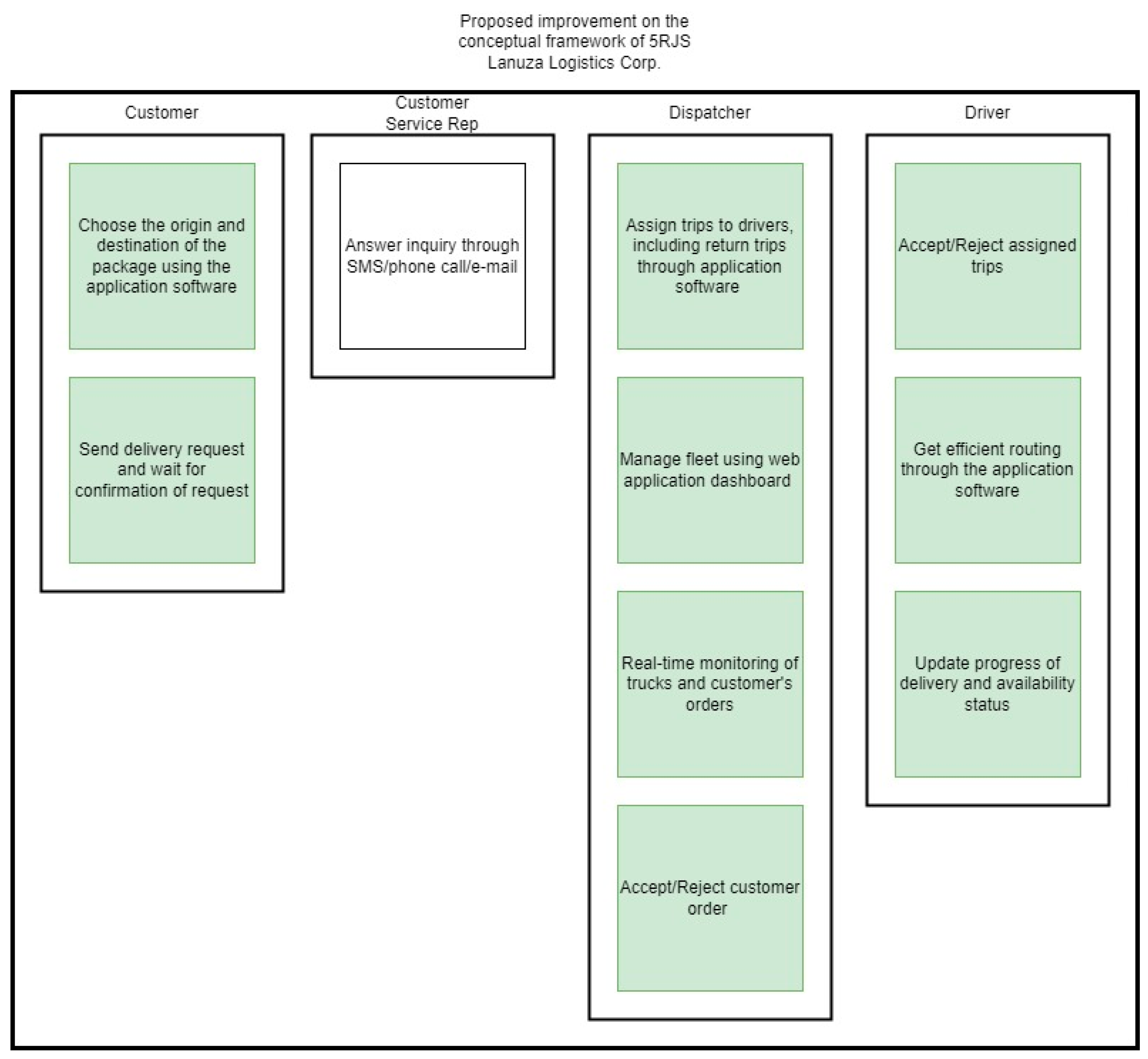
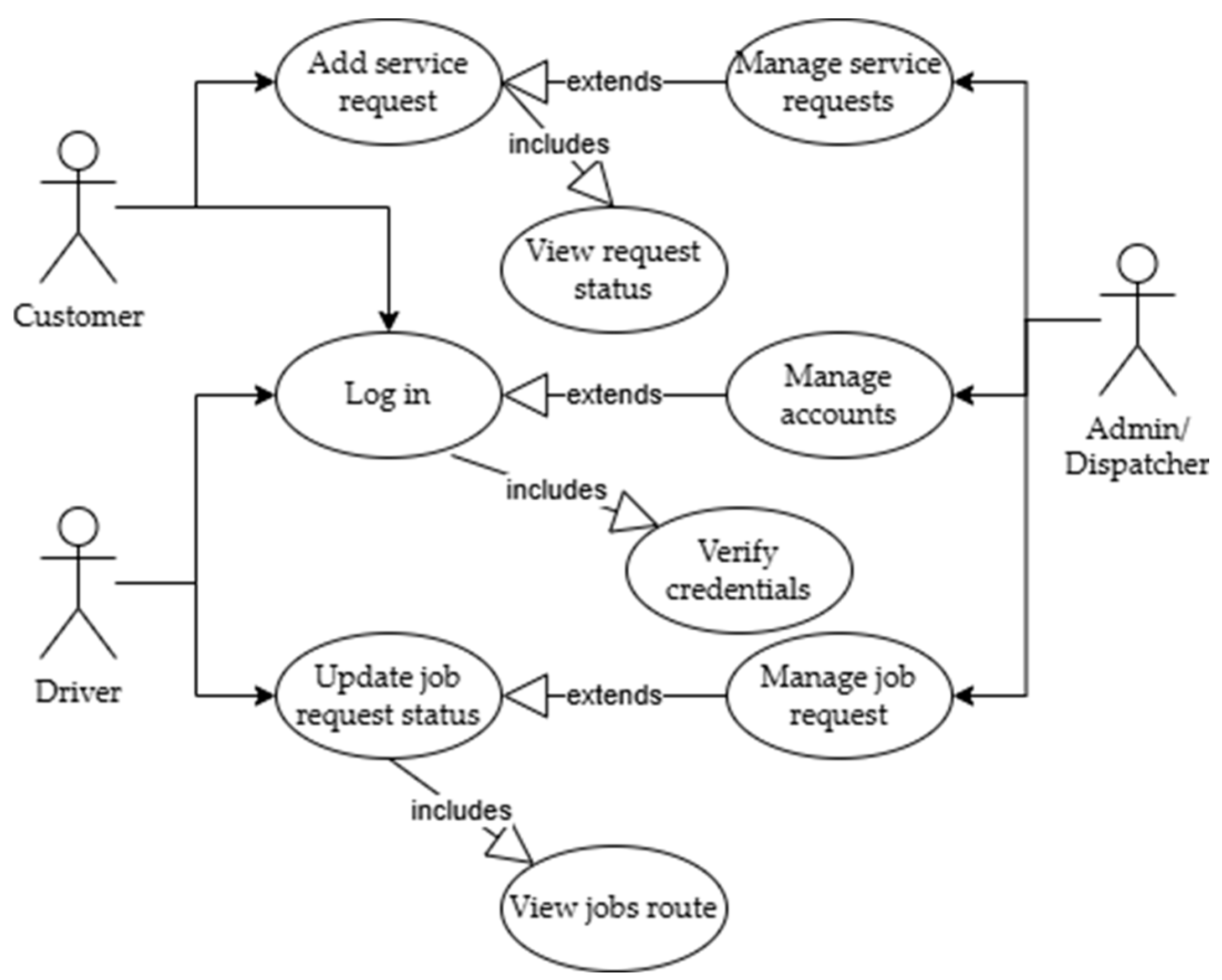

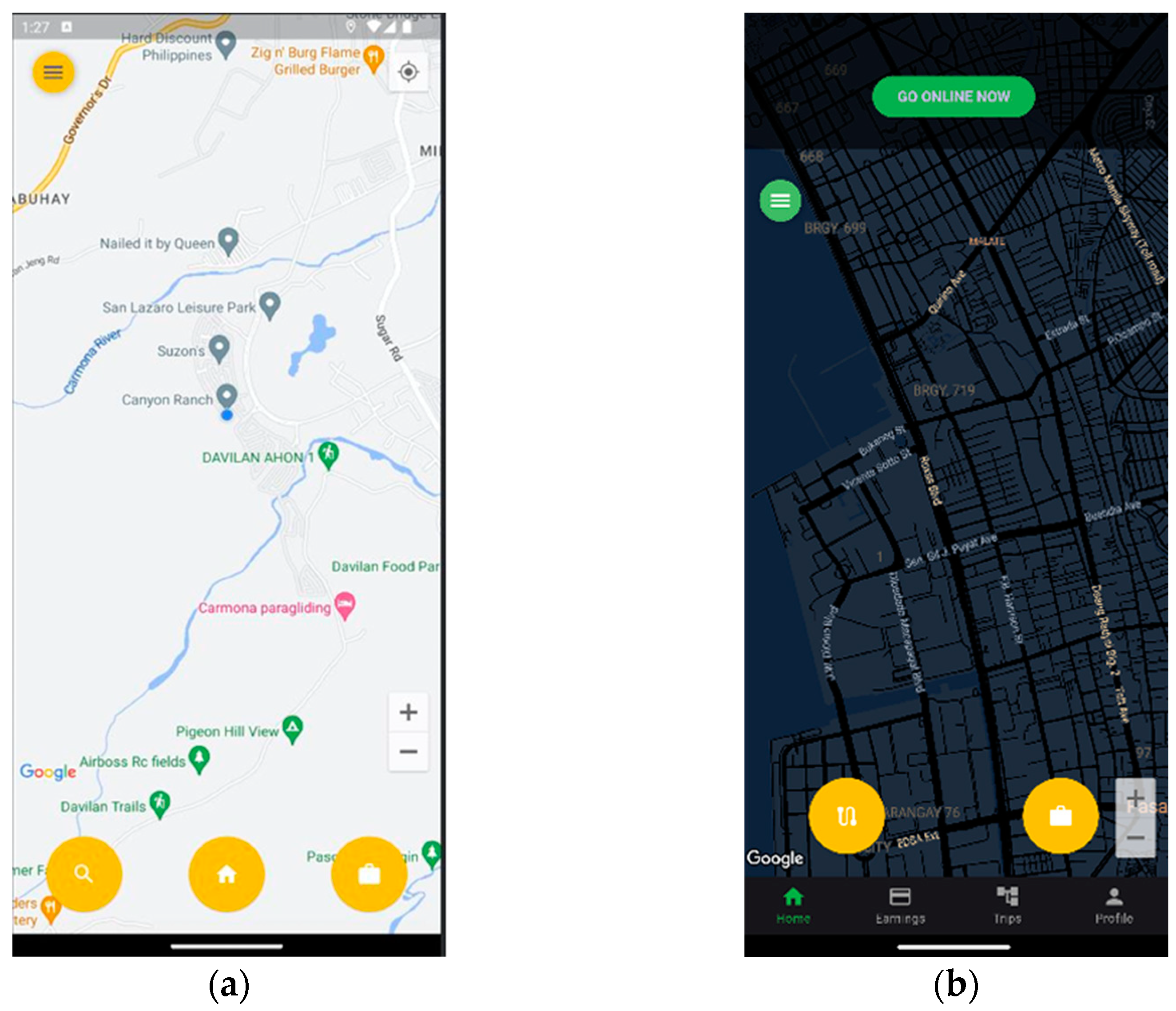
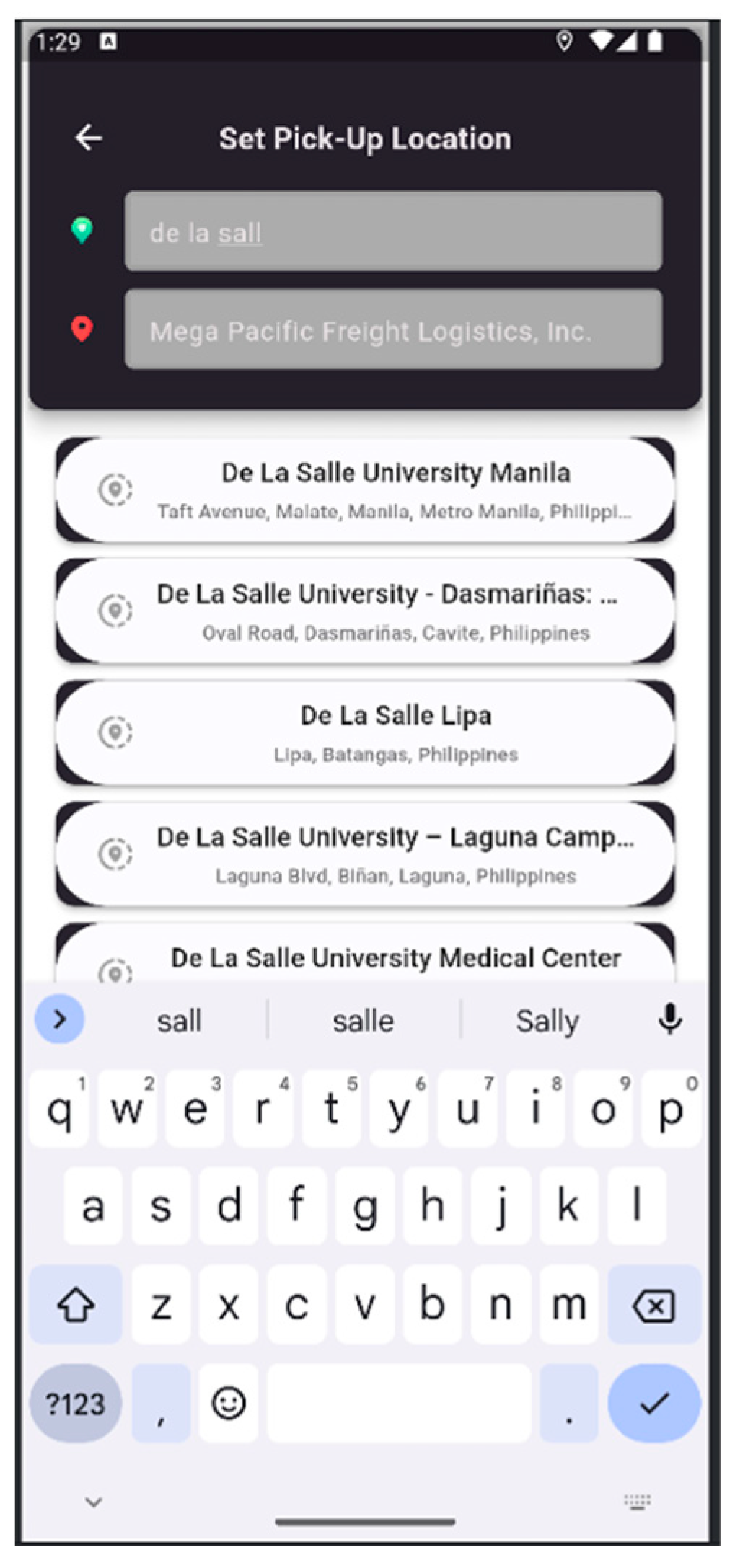

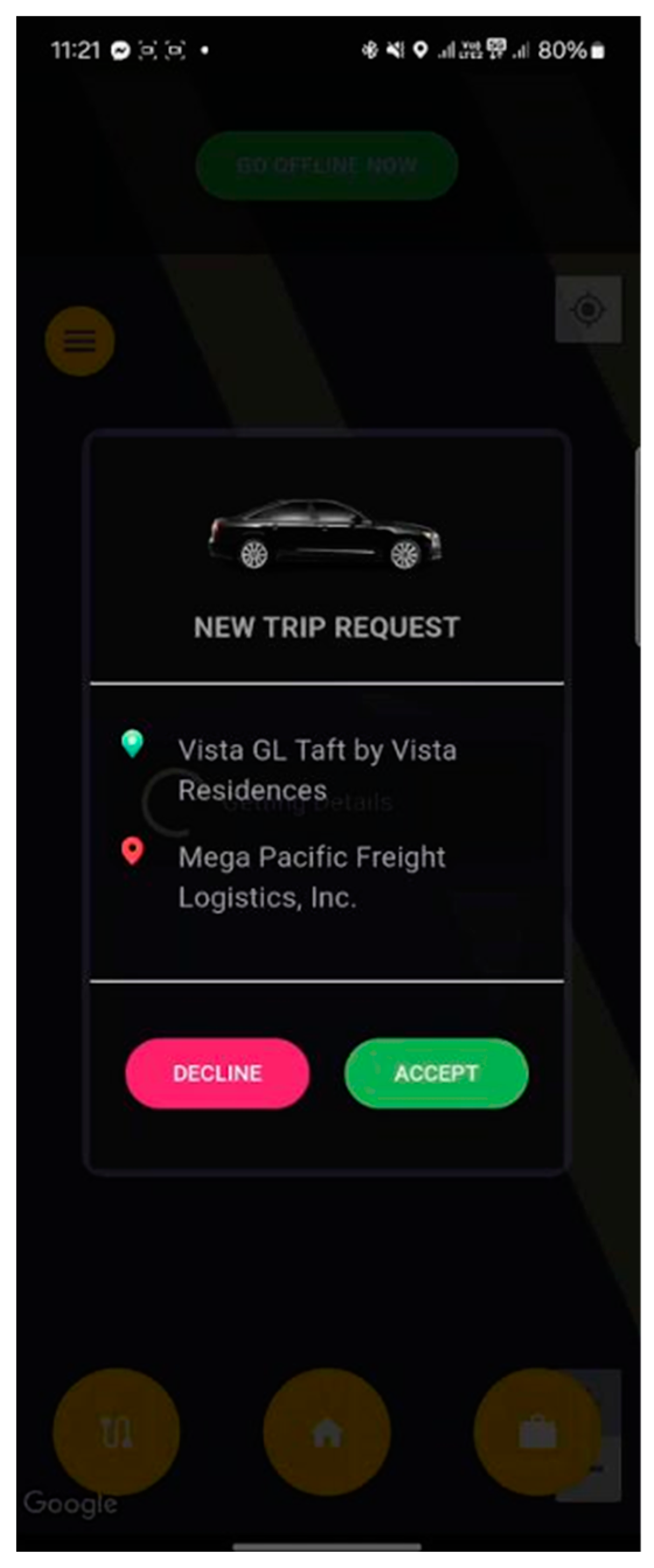
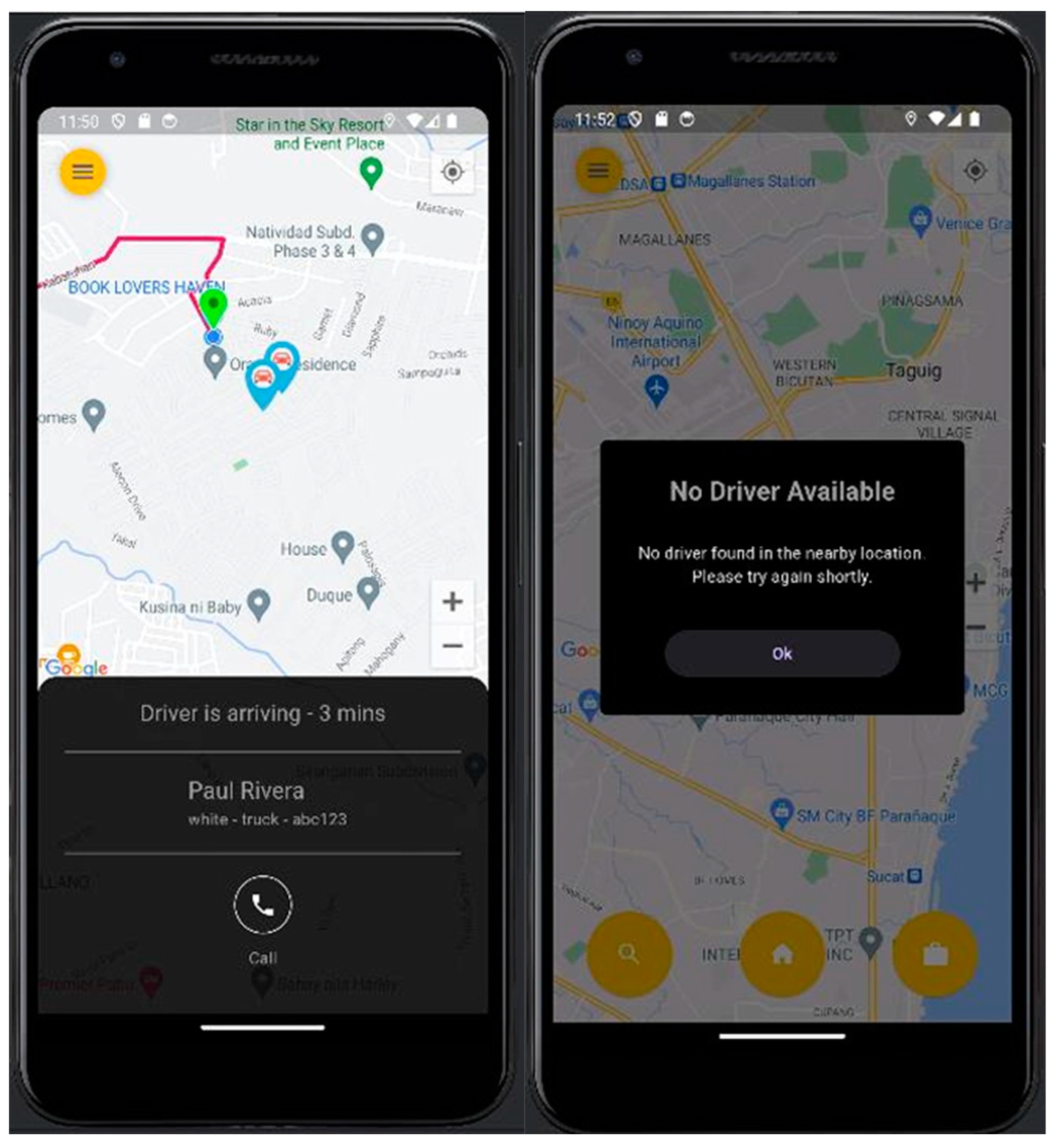
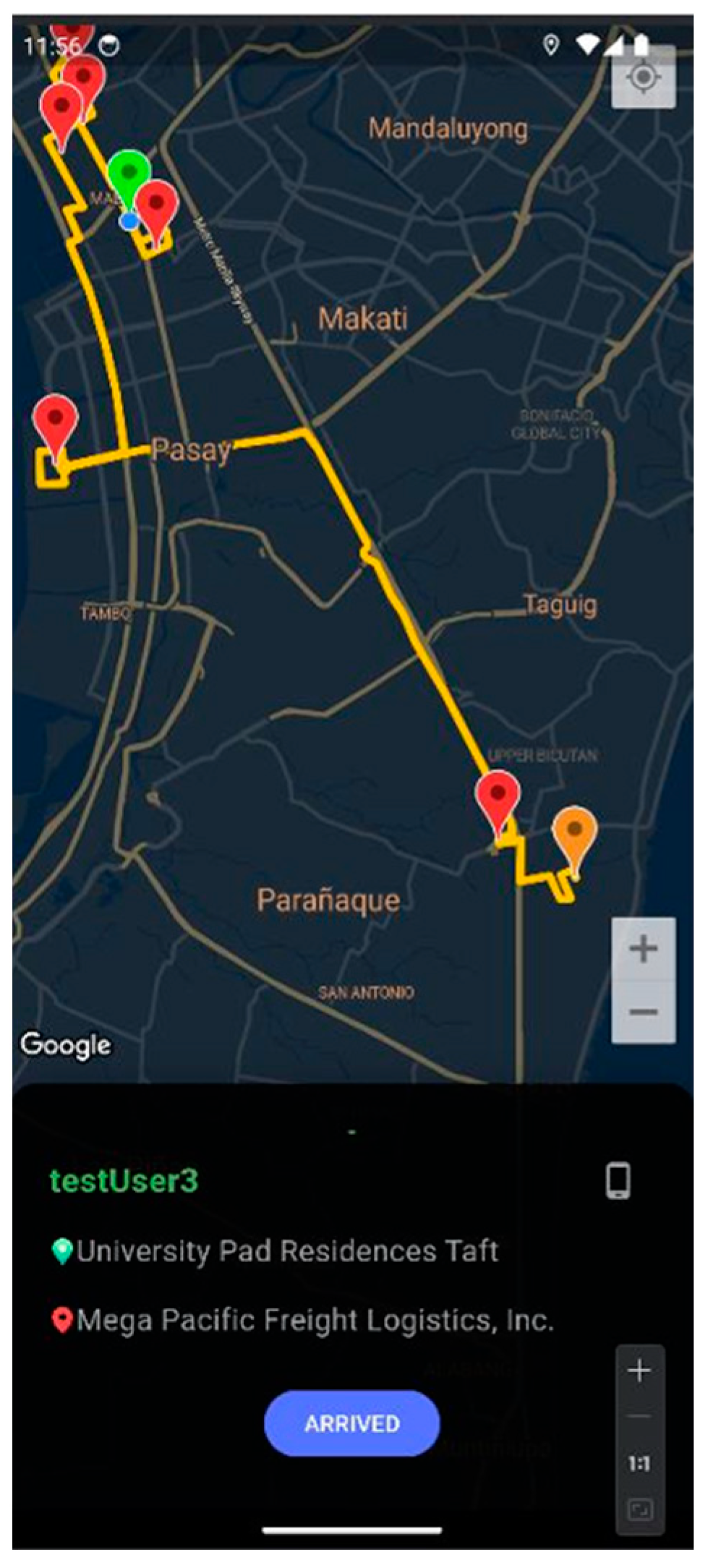
| Title | Discussion | Lacking Approaches |
|---|---|---|
| Dynamic Dispatch Algorithm Proposal for Last-Mile Delivery Vehicle [35] |
|
|
| Studying the Rerouting of Empty Carriers during their Return Trips to Manage Rare Mobile Resources in a Physical Internet [36] |
|
|
| From City Logistics to a Merger of Smart Cities and Smart Logistics from City Logistics to a Merger of Smart Cities and Smart Logistics [37] |
|
|
| Optimal Transfer Point Locations in Two-Stage Distribution Systems [38] |
|
|
| Minimizing Last-Mile Delivery Cost and Vehicle Usage Through an Optimized Delivery Network Considering Customer-Preferred Time Windows [39] |
|
|
| Smart City—Smart Logistics Amalgamation [40] |
|
|
| Logistics Distribution Route Optimization Method for Peach Products Transport [41] |
|
|
| Preparing for the smart cities: IoT enabled last mile delivery [42] |
|
|
| Multimodal Autonomous Last-Mile Delivery System Design and Application [43] |
|
|
| Unmanned Aerial Vehicle Last-Mile Delivery Considering Backhauls [44] |
|
|
| No-Load Backhaul Ratio Reduction by Interactive Routing for Small Goods Delivery with Window Time Constraints [45] |
|
|
| A last-mile delivery problem with alternative delivery options based on prospect theory [46] |
|
|
| Route optimization for last-mile distribution of rural E-commerce logistics based on ant colony optimization [47] |
|
|
| Route optimization using Saving Matrix Method—A Case study at Public Logistics Company in India [48] |
|
|
| Digitalization and third-party logistics performance: exploring the roles of customer collaboration and government support [49] |
|
|
| Impact of Using Third Party Logistics Provider on Organizational Performance in Bulgarian the Context [50] |
|
|
| Innovative solutions to increase last-mile delivery efficiency in B2C e commerce: a literature review [51] |
|
|
| Integrated planning of inbound and outbound logistics with a Rich Vehicle Routing Problem with backhauls [52] |
|
|
| A multiple objective transportation problem approach to dynamic truck dispatching in surface mines [53] |
|
|
| Applicability of Digital Tracking System on Third Party Logistics (TPL) Services [54] |
|
|
| Blockchain Adoption Intention by a Third-Party Logistics Company: A Malaysian Case Study [55] |
|
|
| Roles | User Access |
|---|---|
| Admin/Dispatcher |
|
| Driver |
|
| Customer |
|
| Reference No. | Leadtime | Pick-up | Delivery Area |
|---|---|---|---|
| 11224-1B | 0 to 1 day | Br. Andrew Gonzales Hall | within the Metro |
| 11224-2B | 0 to 1 day | University Pad Residences Taft | within the Metro |
| 11224-3B | 0 to 1 day | Vista GL Taft by Vista Residences | within the Metro |
| 11324-1B | 1 to 2 days | Br. Andrew Gonzales Hall | outside the Metro |
| 11324-2B | 1 to 2 days | University Pad Residences Taft | outside the Metro |
| 11324-3B | 1 to 2 days | Vista GL Taft by Vista Residences | outside the Metro |
| 11324-4B | 1 to 2 days | Robinsons Place Manila | *Return Request |
| Distance in km (2-Way) | Fuel Expenses (PHP) | Fuel Expenses (w/Reclaimed Tax) (PHP) | Labor Cost (PHP) | Total Expenses (PHP) | Freight Rate (PHP) | Freight Rate (Inc. of VAT) (PHP) | Final Freight Rate (PHP) | % Profit per Transaction |
|---|---|---|---|---|---|---|---|---|
| 5 | 40.63 | 36.16 | 955.00 | 991.16 | 1338.06 | 1498.63 | 1500.00 | 33% |
| 10 | 81.25 | 72.31 | 955.00 | 1027.31 | 1386.87 | 1553.30 | 1600.00 | 37% |
| 15 | 121.88 | 108.47 | 955.00 | 1063.47 | 1435.68 | 1607.96 | 1700.00 | 41% |
| 20 | 162.50 | 144.63 | 955.00 | 1099.63 | 1484.49 | 1662.63 | 1700.00 | 36% |
| 25 | 203.13 | 180.78 | 955.00 | 1135.78 | 1533.30 | 1717.30 | 1800.00 | 39% |
| 30 | 243.75 | 216.94 | 955.00 | 1171.94 | 1582.12 | 1771.97 | 1800.00 | 35% |
| 35 | 284.38 | 253.09 | 955.00 | 1208.09 | 1630.93 | 1826.64 | 1900.00 | 38% |
| 40 | 325.00 | 289.25 | 955.00 | 1244.25 | 1679.74 | 1881.31 | 1900.00 | 34% |
| 45 | 365.63 | 325.41 | 955.00 | 1280.41 | 1728.55 | 1935.97 | 2000.00 | 37% |
| 50 | 406.25 | 361.56 | 955.00 | 1316.56 | 1777.36 | 1990.64 | 2000.00 | 34% |
| Distance Travelled | Fuel Expenses (PHP) | Fuel Expenses (w/Reclaimed Tax) (PHP) | Driver’s Fee (PHP) | Helper’s Fee (PHP) | Maintenance Fee (PHP) | Total Expenses (PHP) | Base Freight (PHP) | Per km Rate of PHP 55.00 | Total Freight Rate (PHP) | Total Freight Rate (Inc. of VAT) (PHP) | Final Freight Rate (PHP) | % Profit per Transaction |
|---|---|---|---|---|---|---|---|---|---|---|---|---|
| 5 | 40.63 | 36.16 | 160.00 | 105.00 | 30.00 | 331.16 | 200.00 | 275.00 | 475.00 | 532.00 | 600.00 | 59% |
| 10 | 81.25 | 72.31 | 190.00 | 120.00 | 45.00 | 427.31 | 200.00 | 550.00 | 750.00 | 840.00 | 900.00 | 85% |
| 15 | 121.88 | 108.47 | 220.00 | 135.00 | 60.00 | 523.47 | 200.00 | 825.00 | 1025.00 | 1148.00 | 1200.00 | 102% |
| 20 | 162.50 | 144.63 | 250.00 | 150.00 | 75.00 | 619.63 | 200.00 | 1100.00 | 1300.00 | 1456.00 | 1500.00 | 113% |
| 25 | 203.13 | 180.78 | 280.00 | 165.00 | 90.00 | 715.78 | 200.00 | 1375.00 | 1575.00 | 1764.00 | 1800.00 | 121% |
| 30 | 243.75 | 216.94 | 310.00 | 180.00 | 105.00 | 811.94 | 200.00 | 1650.00 | 1850.00 | 2072.00 | 2100.00 | 128% |
| 35 | 284.38 | 253.09 | 340.00 | 195.00 | 120.00 | 908.09 | 200.00 | 1925.00 | 2125.00 | 2380.00 | 2400.00 | 133% |
| 40 | 325.00 | 289.25 | 370.00 | 210.00 | 135.00 | 1004.25 | 200.00 | 2200.00 | 2400.00 | 2688.00 | 2700.00 | 137% |
| 45 | 365.63 | 325.41 | 400.00 | 225.00 | 150.00 | 1100.41 | 200.00 | 2475.00 | 2675.00 | 2996.00 | 3000.00 | 140% |
| 50 | 406.25 | 361.56 | 440.00 | 245.00 | 170.00 | 1216.56 | 200.00 | 2750.00 | 2950.00 | 3304.00 | 3400.00 | 146% |
| Job Request No. | Service Location | Service (P/D) | Elapsed Time (mins) | Reference No. |
|---|---|---|---|---|
| Pick-Up Location | Mega Pacific Freight Logistics, Inc. | - | 0 | |
| 0 | Br. Andrew Gonzales Hall | P | 40 | 11324-1B |
| 1 | University Pad Residences Taft | P | 17.35 | 11324-2B |
| 2 | Vista GL Taft by Vista Residences | P | 42.83 | 11324-3B |
| 3 | Robinsons Place Manila | P | 18 | 11324-4B |
| 4 | Adamson University Main Building | D | 14.35 | 11224-1B |
| 5 | SM Mall of Asia | D | 47.97 | 11224-3B |
| 6 | SM City Bicutan | D | 61.82 | 11224-2B |
| Drop-off Location | Mega Pacific Freight Logistics, Inc. | - | 49.75 | - |
| Job Total Time: | 292.07 |
| Job Request No. | Pick-up/Delivery Location No. | Service (P/D) | Elapsed Time (mins) | Reference No. |
|---|---|---|---|---|
| Pick-Up Location | Mega Pacific Freight Logistics, Inc. | - | 0 | |
| 0 | Br. Andrew Gonzales Hall | P | 35 | 11324/11224-1B |
| 1 | University Pad Residences Taft | P | 8.23 | 11324/11224-2B |
| 2 | Vista GL Taft by Vista Residences | P | 16.78 | 11324/11224-3B |
| 3 | Robinsons Place Manila | P | 8.6 | 11324-4B |
| 4 | Adamson University Main Building | D | 13.93 | 11224-1B |
| 5 | SM Mall of Asia | D | 31.63 | 11224-3B |
| 6 | SM City Bicutan | D | 52.85 | 11224-2B |
| Drop-off Location | Mega Pacific Freight Logistics, Inc. | - | 19.75 | - |
| Job Total Time: | 186.77 |
| Turnaround Time | ||
|---|---|---|
| Elapsed Time | Job Request | |
| Old Framework | 292.07 | 7 |
| New Framework | 186.77 | 10 |
| % Difference: | 36.05% | 42.86% |
| Turnaround Time | |||
|---|---|---|---|
| Reference No. | Old Framework | New Framework | % Time Savings |
| 11224-1B | 852.53 | 47.54 | 94.42% |
| 11224-2B | 962.32 | 123.79 | 87.14% |
| 11224-3B | 900.5 | 54.16 | 93.99% |
| Average % Time Savings per Request: | 91.85% | ||
| Old Framework | New Framework | |||||
|---|---|---|---|---|---|---|
| Job Request No. | Service Location | Service (P/D) | Reference No. | Distance Traveled from Previous Location (km) | Reference No. | Distance Traveled from Previous Location (km) |
| Pick-Up Location | Mega Pacific Freight Logistics, Inc. | - | 0 | 0 | ||
| 0 | Br. Andrew Gonzales Hall | P | 11324-1B | 15.5 | 11324/11224-1B | 15.5 |
| 1 | University Pad Residences Taft | P | 11324-2B | 0.7 | 11324/11224-2B | 0.7 |
| 2 | Vista GL Taft by Vista Residences | P | 11324-3B | 2.5 | 11324/11224-3B | 2.6 |
| 3 | Robinsons Place Manila | P | 11324-4B | 0.4 | 11324-4B | 1.5 |
| 4 | Adamson University Main Building | D | 11224-1B | 2.1 | 11224-1B | 1.6 |
| 5 | SM Mall of Asia | D | 11224-3B | 7.9 | 11224-3B | 6.9 |
| 6 | SM City Bicutan | D | 11224-2B | 11.8 | 11224-2B | 11.9 |
| Drop-off Location | Mega Pacific Freight Logistics, Inc. | - | - | 4.1 | 3 | |
| Distance Traversed (km) | Fuel Expenses (PHP) | CO2 Emissions (kg/veh-km) | |||||
|---|---|---|---|---|---|---|---|
| Reference No. | Old | New | Old | New | Old | New | % Savings |
| 11224-1B | 17.60 | 1.60 | 143.00 | 13.00 | 4.96502 | 0.45137 | 90.91% |
| 11224-2B | 12.50 | 11.90 | 101.56 | 96.69 | 3.52629 | 3.35703 | 4.80% |
| 11224-3B | 10.40 | 6.90 | 84.50 | 56.06 | 2.93387 | 1.94651 | 33.65% |
| Average % Savings per Request: | 43.12% | ||||||
| Old | New | ||
|---|---|---|---|
| Particulars | Amount (PHP) | Amount (PHP) | Remarks |
| Labor Cost | 1910.00 | 625.00 | see Table 5 for labor rates using new framework |
| Driver’s Wage | 1100.00 | 400.00 | PHP 550 per day for 2 days |
| Helper’s Wage | 810.00 | 225.00 | PHP 405 per day for 2 days |
| Fuel Cost | 650.81 | 316.01 | |
| Day 1 Job Requests | 325.41 | - | Pick-up of RF# 11224-1B to 3B |
| Day 2 Job Requests | 325.41 | - | Delivery of Day 1 RF# and Pick-up of RF#11324-1B TO 4b |
| Maintenance Cost | - | 150.00 | |
| Total Expenses: | 2560.81 | 1091.01 | 57.40% savings |
| Reference No. | Status | Distance in km (2-Way) | Old Freight Charge (PHP) | New Freight Charge (PHP) | |
|---|---|---|---|---|---|
| 11224-1B | Complete | 11.4 | 1600 | 1000 | |
| 11224-2B | Complete | 49.4 | 2000 | 3300 | |
| 11224-3B | Complete | 20.8 | 1700 | 1600 | |
| 11324-1B | For Next-Day Delivery | - | |||
| 11324-2B | For Next-Day Delivery | - | |||
| 11324-3B | For Next-Day Delivery | - | |||
| 11324-4B | Complete | 51.8 | 2100 | 3500 | % Increase |
| Total Revenue: | 7400 | 9400 | 27.03% | ||
| Total Expenses: | 2560.81 | 1091.01 | |||
| Total Profit: | 4839.19 | 8308.99 | 71.70% |
| Category | Survey Item | Mean Score |
|---|---|---|
| User Experience | The application software is user-friendly. | 4.1 |
| The interface of the application software is intuitive and easy to navigate. | 4.0 | |
| Features on the application software will significantly improve workflow efficiency. | 4.4 | |
| Maintenance of Vehicles | The application software will help lessen the strain on vehicles. | 4.6 |
| The application software will contribute to extending the lifespan of the vehicles in the fleet. | 4.7 | |
| Safety | The application software will positively influence the safety of the driver and helper during operations. | 4.4 |
| The route optimization will reduce fatigue and enhance the safety of the work environment since it will lessen the worry of manually planning the route ahead. | 4.8 | |
| Seamless Navigation | I am satisfied with the accuracy and reliability of the navigation system within the application software. | 4.4 |
| The navigation feature will help avoid delays and optimize delivery routes effectively. | 4.5 | |
| Optimization in Operations | The application software has significantly reduced the manual effort required by dispatchers and drivers in logistics operations. | 4.8 |
| Automated processes like order processing and inventory management will improve overall efficiency. | 4.9 | |
| Seamless Integration | The application software seamlessly integrates with existing systems (return trips and consolidated shipping) in operations. | 4.1 |
Disclaimer/Publisher’s Note: The statements, opinions and data contained in all publications are solely those of the individual author(s) and contributor(s) and not of MDPI and/or the editor(s). MDPI and/or the editor(s) disclaim responsibility for any injury to people or property resulting from any ideas, methods, instructions or products referred to in the content. |
© 2024 by the authors. Published by MDPI on behalf of the International Society for Photogrammetry and Remote Sensing. Licensee MDPI, Basel, Switzerland. This article is an open access article distributed under the terms and conditions of the Creative Commons Attribution (CC BY) license (https://creativecommons.org/licenses/by/4.0/).
Share and Cite
Agoo, J.; Lanuza, R.J.; Lee, J.; Rivera, P.A.; Velasco, N.O.; Guillermo, M.; Fernando, A. Geographic Information System-Based Framework for Sustainable Small and Medium-Sized Enterprise Logistics Operations. ISPRS Int. J. Geo-Inf. 2025, 14, 1. https://doi.org/10.3390/ijgi14010001
Agoo J, Lanuza RJ, Lee J, Rivera PA, Velasco NO, Guillermo M, Fernando A. Geographic Information System-Based Framework for Sustainable Small and Medium-Sized Enterprise Logistics Operations. ISPRS International Journal of Geo-Information. 2025; 14(1):1. https://doi.org/10.3390/ijgi14010001
Chicago/Turabian StyleAgoo, Jonathan, Renz Joshua Lanuza, Jonathan Lee, Paul Anthony Rivera, Neil Oliver Velasco, Marielet Guillermo, and Arvin Fernando. 2025. "Geographic Information System-Based Framework for Sustainable Small and Medium-Sized Enterprise Logistics Operations" ISPRS International Journal of Geo-Information 14, no. 1: 1. https://doi.org/10.3390/ijgi14010001
APA StyleAgoo, J., Lanuza, R. J., Lee, J., Rivera, P. A., Velasco, N. O., Guillermo, M., & Fernando, A. (2025). Geographic Information System-Based Framework for Sustainable Small and Medium-Sized Enterprise Logistics Operations. ISPRS International Journal of Geo-Information, 14(1), 1. https://doi.org/10.3390/ijgi14010001







